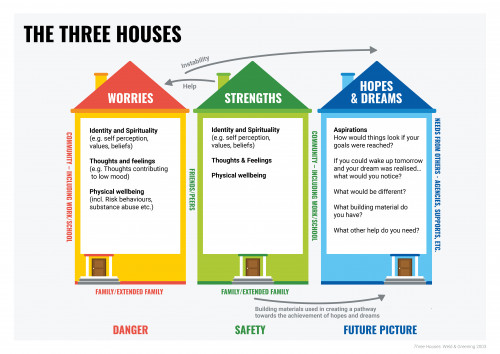Practice tool
Three Houses engagement tool
The Three Houses are a visual way to identify strengths, risks and vulnerabilities as well as the hopes and dreams of te tamaiti and their whānau or family.Upcoming changes for this content
What are the Three Houses
The Three Houses are a visual way to identify strengths, risks and vulnerabilities, and to build a picture of what te tamaiti and their whānau or family would like to see happening in their world — their hopes and dreams.

View full size image (JPG 2.2 MB) Download image (JPG 2.2 MB)
When to use them
Use the Three Houses whenever you need to seek the views of te tamaiti or their whānau or family. The Three Houses remind us to focus not only on the worries but also on the things that are going well and to imagine a brighter future.
How to use them
There is a template, or you can use a blank piece of paper to record their views.
Three Houses template (PDF 795 KB)
Worries
This house is about worries, danger and harm.
It covers:
- identity and spirituality (eg self-perception, values, beliefs)
- thoughts and feelings (eg thoughts contributing to low mood)
- physical wellbeing (including risk behaviours, substance abuse).
Strengths
This house is also about safety.
It covers:
- identity and spirituality (eg self-perception, values, beliefs)
- thoughts and feelings
- physical wellbeing.
Hopes and dreams
This house is about the future picture — what te tamaiti and their whānau or family would like to see happening in their world.
Questions to ask
What makes your house vulnerable, sad or insecure?
What makes your house strong, happy or good?
What do you want to do or be when you grow up?
What are your goals and aspirations?
How would things look if your goals were reached?
What would you like to be different in your life?
If you could wake up tomorrow and your dream was realised, what would you notice?
What building material do you have?
What other help do you need? From agencies, supports, etc.
Remember:
- Use a questioning approach and be a naive enquirer.
- Don't rush, be comfortable with silence and allow time for free narrative.
- Use te reo or culturally appropriately language to engage tamariki.
- Consider the purpose of your visit and focus your questions under each house to explore their views.
Connections between the Three Houses
Worries can undermine people’s strengths and their hopes and dreams.
The strengths and good things in a person’s world can help them manage the worries, and reach their hopes and dreams.
The hopes and dreams need to link back to the worries so they can help increase safety and build protective factors.
Supporting the Three Houses
The three houses are supported by:
- the community, including work or school
- family and whānau
- friends and peers.
